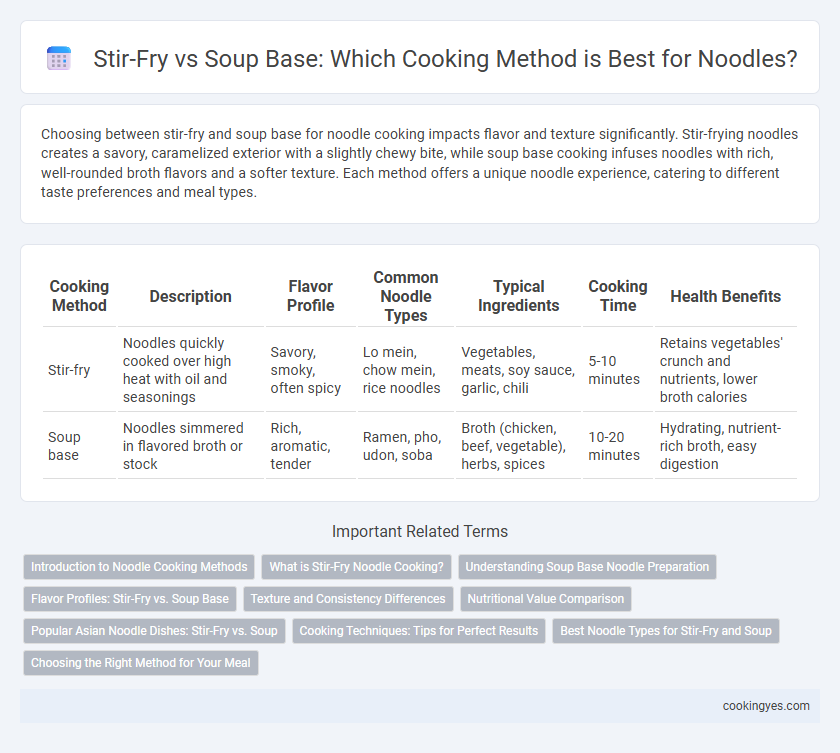Choosing between stir-fry and soup base for noodle cooking impacts flavor and texture significantly. Stir-frying noodles creates a savory, caramelized exterior with a slightly chewy bite, while soup base cooking infuses noodles with rich, well-rounded broth flavors and a softer texture. Each method offers a unique noodle experience, catering to different taste preferences and meal types.
Table of Comparison
| Cooking Method | Description | Flavor Profile | Common Noodle Types | Typical Ingredients | Cooking Time | Health Benefits |
|---|---|---|---|---|---|---|
| Stir-fry | Noodles quickly cooked over high heat with oil and seasonings | Savory, smoky, often spicy | Lo mein, chow mein, rice noodles | Vegetables, meats, soy sauce, garlic, chili | 5-10 minutes | Retains vegetables' crunch and nutrients, lower broth calories |
| Soup base | Noodles simmered in flavored broth or stock | Rich, aromatic, tender | Ramen, pho, udon, soba | Broth (chicken, beef, vegetable), herbs, spices | 10-20 minutes | Hydrating, nutrient-rich broth, easy digestion |
Introduction to Noodle Cooking Methods
Stir-fry and soup base are two essential noodle cooking methods, each bringing distinct textures and flavors to dishes. Stir-frying noodles involves high-heat cooking with minimal liquid, preserving a chewy texture and allowing ingredients like vegetables and proteins to caramelize, enhancing savory taste. Soup-based cooking submerges noodles in broth, infusing them with rich, aromatic flavors and producing a comforting, warm meal often characterized by a balance of umami and seasoning.
What is Stir-Fry Noodle Cooking?
Stir-fry noodle cooking involves quickly frying noodles with a variety of ingredients such as vegetables, meat, and sauces over high heat, which enhances texture and flavor through caramelization. This method contrasts with soup-based cooking, where noodles are simmered in broth, resulting in a softer texture and a richly infused taste. Stir-frying retains the noodles' firmness and creates a savory, often slightly charred, taste that highlights the ingredients' freshness.
Understanding Soup Base Noodle Preparation
Soup base noodle preparation involves simmering aromatic broths infused with ingredients like bone marrow, herbs, and spices to create a rich, flavorful foundation that enhances noodle texture and taste. Unlike stir-fry methods, which rely on high heat and quick cooking, soup base cooking allows noodles to absorb the broth's depth, resulting in a harmonious blend of savory and umami flavors. Mastering the balance of seasoning and simmering time is critical for achieving a perfect soup base that elevates the noodle dish's overall complexity and satisfaction.
Flavor Profiles: Stir-Fry vs. Soup Base
Stir-fry noodles deliver a bold, caramelized flavor with a rich, savory intensity from soy sauce, garlic, and toasted oils. In contrast, soup-base noodles offer a delicate, aromatic profile that highlights umami-rich broths infused with ingredients like ginger, bone marrow, and herbs. The stir-fry method emphasizes concentrated, robust tastes while soup-base cooking provides a soothing, layered flavor experience.
Texture and Consistency Differences
Stir-fry noodles feature a firm, chewy texture with a slightly crispy exterior, achieved through high-heat cooking that caramelizes the ingredients and evaporates moisture quickly. In contrast, soup-based noodles offer a softer, more tender bite as they simmer in flavorful broths, absorbing liquid that creates a rich, silky consistency. The stir-fry method emphasizes a dry, textured finish, while soup base cooking results in a moist, comforting mouthfeel.
Nutritional Value Comparison
Stir-fry noodles typically contain less liquid, preserving more fats and nutrients from oils and ingredients, which can increase calorie density but also enhance fat-soluble vitamins. Soup-based noodle dishes offer higher hydration and can incorporate a wider variety of vegetables and proteins, often providing more vitamins, minerals, and antioxidants through the broth. Nutritionally, stir-fry noodles may deliver more concentrated macronutrients, while soup-based noodles emphasize micronutrients and hydration, making each method beneficial depending on dietary goals.
Popular Asian Noodle Dishes: Stir-Fry vs. Soup
Stir-fry noodle dishes like Pad Thai and Chow Mein feature a quick, high-heat cooking method that preserves the noodles' firm texture and enhances flavors through caramelization and spices. In contrast, soup-based noodles such as Pho and Ramen rely on rich, aromatic broths that infuse the noodles with deep, savory tastes while offering a comforting, hydrating meal. Both methods showcase distinct textures and flavor profiles, making them staples in popular Asian cuisine with diverse regional variations.
Cooking Techniques: Tips for Perfect Results
Stir-frying noodles requires high heat and continuous tossing to achieve a lightly charred, flavorful texture, while preventing sogginess. Soup-based noodle cooking demands simmering broth with balanced seasonings and timely noodle addition to maintain firmness and absorb rich flavors. Mastering precise heat control and cooking times ensures optimal noodle texture and taste in both methods.
Best Noodle Types for Stir-Fry and Soup
Wheat-based noodles such as udon and lo mein are ideal for stir-frying due to their firm texture and ability to absorb sauces without becoming mushy. For soup bases, rice noodles and egg noodles excel because they cook quickly and retain a delicate consistency that complements broth flavors. Choosing the right noodle type enhances the dish's texture and flavor balance in both stir-fry and soup preparations.
Choosing the Right Method for Your Meal
Stir-fry enhances noodle dishes by providing a quick, high-heat cooking method that locks in bold flavors and crisp textures, ideal for meals packed with fresh vegetables and proteins. Soup bases offer a comforting and flavorful liquid environment, perfect for creating rich, aromatic broths that elevate the noodles' taste and provide warmth. Selecting between stir-fry and soup base depends on personal preference, desired texture, and the overall flavor profile you aim to achieve in your noodle meal.
Stir-fry vs soup base for noodle cooking method Infographic

 cookingyes.com
cookingyes.com